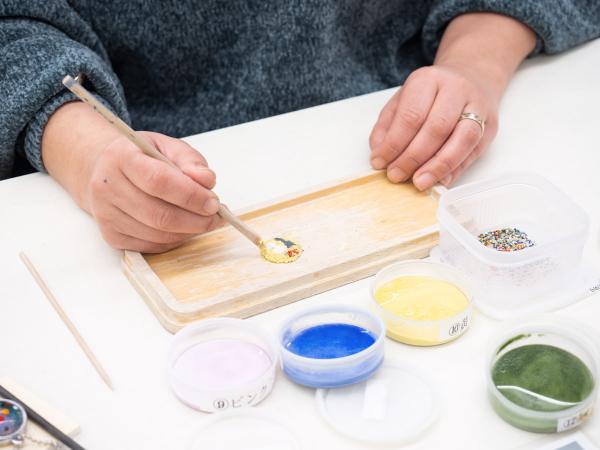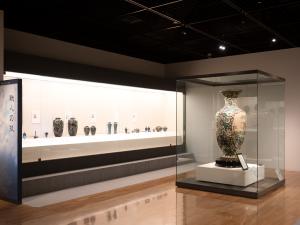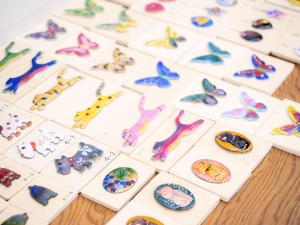- HOME
- Search in the site
- Shippo Art Village
At first sight, Japanese Shippo-yaki looks like intricately hand painted porcelain, but in reality it is richly decorated metalwork objects covered in kiln fired cloisonné enamel. Cloisonne enamelware was a metal working technique using fine, flat copper, silver or gold wires, cut, bent, and soldered or glued to the metal base item, then filled with finely ground colored glass paste, and fired at high temperatures to produce a glossy pattern or design. The wires become part of the work, framing the designs, but also keept the molten enamel in place during firing. Each of the pieces is fired four to eight times, resulting in a deeper, richer glaze. The works are then highly polished bringing out the smooth, glassy surface features of Japanese Shippo-yaki.
The techniques were first developed in Mesopotamia, and spread to Egypt, China, and eventually Japan. The Japanese artisans of Aichi perfected the techniques, creating large quantities of very highly skilled work. From about 1833, Aichi Prefecture was the center of cloisonné production, which became known as Shippo-yaki after the area in which it was produced. Shippo means “Seven Treasures”, and is taken from the Buddhist scriptures regarding the beauty of seven kinds of treasure. “Yaki” means kiln fired. Aichi Prefectures’ Shippo-yaki became world famous, much sought after and prized following its inclusion in the Paris International Exposition of 1867, and is designated a traditional Japanese craft.
One of the best places to see and experience Shippo-yaki is at the Shippo Art Village in Ama City, just west of Nagoya. Masterpiece works are on display in the Fureai Museum, where you can see and learn about the craft and its history. Watch a Shippo artisan at work in the Active Exhibition Zone, and even try making your own accessories and items in the workshop area. Light refreshments are available in the lobby café, and quality shippo-yaki wares are on sale too.
Enjoy Making Original Shippo-yaki at Shippo Art Village Workshop

• Fee:
[60-minute course] 1,000 yen to 1,500 yen
[90-minute course] 1,500 to 2,000 yen
[120-minute course] 1,500 yen to 5,000 yen
*: Fee varies according to item. For details, please see the official web site (Japanese).
• Reception Time 9:30 AM to 3:30 PM
[Morning] (Lunch break from 12:00 PM to 1:00 PM
From 10:00 AM (Reception ends for 120-minute workshop course)
From 10:30 AM (Reception ends for 90-minute workshop course)
From 11:00 AM
[Afternoon]
From 1:00 PM
From 1:30 PM
From 2:00 PM
From 2:30 PM (Reception ends for 120-minute workshop courses)
From 3:00 PM (Reception ends for 90-minute workshop courses)
From 3:30 PM
*: Please visit the reception desk by the start time.
*: Advance reservations required for groups of 10 people or more.
| Location | : 〒497-0002 2000, Jusanwari Toshima, Shippo-cho, Ama-City, Aichi |
|---|---|
| Fee | : Admission free. Art exhibitions charged separately. Admission fee: adults (high school age and over) 310 yen, elementary and junior high school students 100 yen |
| Opening days / hours |
: Interaction Hall 9:00 to 21:00, other facilities 9:00 to 17:00 Fureai Open Lawn March to November 8:30 to 21:00 December to February 8:30 to 19:00 |
| Parking | : 100 parking spaces |
|---|---|
| Holidays | : Every Monday, the day after a public holiday (if this is a Monday, the following day), year-end and New Years (December 29 to January 3) |
| Phone number | : 052-443-7588 |
Note: This page may not be current due to update time differences between site databases.
Should accuracy be critical, please verify this information using a direct source, whenever possible.
Barrier-free information
ACCESS
-

- Access by public transport
- From Nagoya Station, take the Meitestu Tsushima Line. Alight at Shippo Station and 25 minutes walk.
Or alight at Kida Station and 5 minutes by taxi.
-

- Access by car
- 20 minutes from Nagoya Station
Share spot information with a smartphone
ACCESS MAP
 Keyword
Keyword- #Shippo Art Village
INFORMATION ON THE SURROUNDING AREA
- Tomiyoshi Tatehaya Jinja Shrine and Hakkensha Shrine
- Located on the east bank of the Kanie River, the enshrined deity at Tomiyoshi Tatehaya Jin...
- Nagoya City Hideyoshi & Kiyomasa Memorial Museum
- A history museum on the 2nd floor of Nakamura Park Cultural Plaza. The museum mainly colle...
- Toyokuni Shrine (Toyokuni Jinja)
- In 1885, Toyokuni Shrine was established in Owari Nakamura (present day Nakamura Ward, Nag...
- Birthplace of Oda Nobunaga / Shobata Castle Site
- According to the ancient manuscript, "Records of Owari Castles," defining the birth sites ...
- Kiyosu Castle
- Kiyosu Castle was the starting point of local feudal lord and hero Oda Nobunaga on his cam...
- Toyota Commemorative Museum of Industry and Technology
- Japan’s manufacturing industry has long been the envy of other nations. One of the greates...

















































